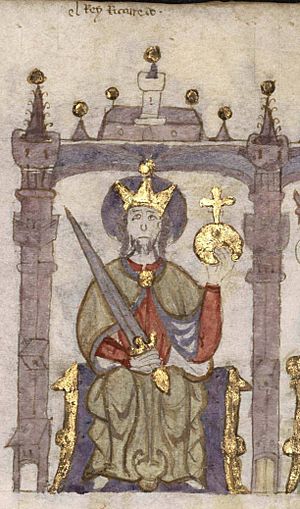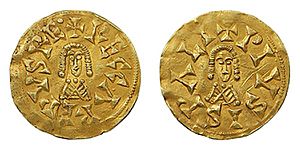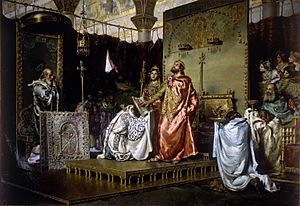Reccared I facts for kids
Quick facts for kids Reccared I |
|||||
|---|---|---|---|---|---|
| King of Hispania, Septimania and Gallaecia | |||||

Imaginary portrait of Reccared I by an unknown artist. dated between 1312-1325
|
|||||
| King of the Visigoths | |||||
| Reign | 21 April 586 – 21 December 601 | ||||
| Predecessor | Liuvigild | ||||
| Successor | Liuva II | ||||
| Born | c. 559 AD Hispania |
||||
| Died | 21 December 601 Toledo, Hispania |
||||
| Spouse | Baddo | ||||
| Issue | Liuva II Suintila Geila |
||||
|
|||||
| Father | Liuvigild | ||||
| Mother | Theodosia | ||||
| Religion | Arianism, later Chalcedonian Christianity |
||||
Reccared I (also known as Recared) was a powerful Visigothic king who ruled parts of what is now Spain and France. He was born around 559 AD and became king in 586. His reign is famous because he made a very important change: he switched from the Arian Christian faith to the Roman Christian faith in 587. This decision changed the history of the Visigothic Kingdom forever.
Contents
King Reccared I: His Reign and Conversion
Reccared was the younger son of King Leovigild. Like his father, Reccared made the city of Toledo his capital. At that time, the Visigothic kings and nobles followed a type of Christianity called Arianism. However, most of the people living in the land, the Hispano-Romans, were Roman Christians.
Becoming King
When King Leovigild died in 586, Reccared became king. He had already been helping his father rule, so the Visigothic nobles accepted him as their new leader without any problems. A very important religious leader named Leander of Seville, a Roman Christian bishop, had played a role in the past. He had even helped Reccared's older brother, Hermenegild, convert to Roman Christianity.
Changing Religions
In January 587, Reccared made his biggest decision: he gave up Arianism and became a Roman Christian. This was a huge moment for the Visigothic Kingdom. Most of the Arian nobles and church leaders in Toledo followed his lead and also converted.
However, not everyone was happy about this change. Some Arian groups started rebellions, especially in Septimania, a northern province beyond the Pyrenees mountains. One of the main leaders of this opposition was an Arian bishop named Athaloc. Other leaders even asked for help from Guntram, the King of Burgundy. Reccared's army fought against these rebels and their allies, defeating them.
More challenges appeared in the west, in a region called Lusitania. An Arian bishop named Sunna and a count named Seggo led another uprising. Reccared's general, Claudius, stopped this rebellion. Sunna was sent away, and Seggo left the area. Later, in 588, another plot was discovered, led by an Arian bishop named Uldila and the queen dowager Goiswintha. They were also stopped, and the bishop was sent away.
The Third Council of Toledo
In May 589, a very important meeting called the Third Council of Toledo took place. Bishop Leander helped organize it, but it was held in King Reccared's name. This council set the rules for the new Roman Christian kingdom. Reccared made a public statement, read aloud, explaining his faith. Bishop Leander also gave a powerful speech about the "triumph of the Church" because of the Goths' conversion.
After this, the Roman Christian bishops began to encourage the conversion of Jewish people and to remove the last parts of Arianism, which they saw as a wrong belief. Over time, the differences between the Visigoths and the Hispano-Romans became less clear. The Gothic language, for example, stopped being used in churches.
Reccared and the Jewish Community
Some historical writings suggest that Reccared was very strict with the Jewish community. However, modern historians now believe that he continued the Visigothic tradition of being more tolerant. For example, Pope Gregory I thought Reccared refused money from the Jewish community to change certain laws. But Reccared's laws did say that children born from a Christian and a Jewish parent should be baptized. Also, Reccared removed the death penalty for Jewish people who tried to convert Christians. He also did not stop Jewish people from trading Christian slaves in Narbonne, even though Pope Gregory asked him to. Historians have found no laws from five different church meetings during Reccared's reign that were unfair to the Jewish community.
His Rule and Legacy
Not much information is available about the rest of Reccared's reign. Historians from his time praised his peaceful rule, his kindness, and his generosity. He gave back properties that his father had taken and helped build many churches and monasteries.
Pope Gregory I wrote to Reccared in 599, praising him for accepting the true faith and encouraging his people to do the same. The Pope also sent Reccared some special religious items, like a piece of the True Cross and fragments of chains believed to belong to St. Peter.
Reccared was married to Baddo and possibly to Chlodoswintha. He died naturally in Toledo in December 601. His young son, Liuva II, became king after him.
See also
 In Spanish: Recaredo I para niños
In Spanish: Recaredo I para niños



